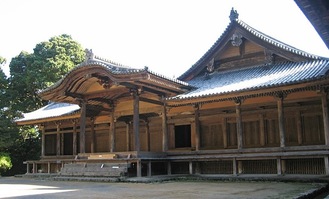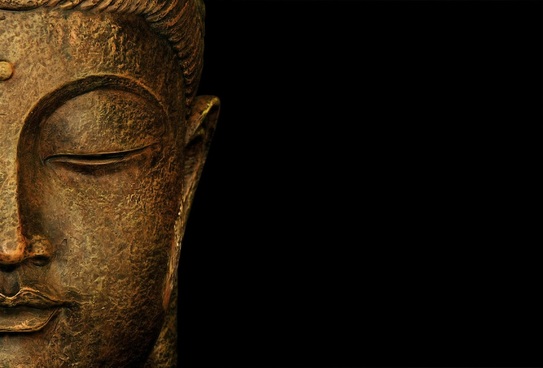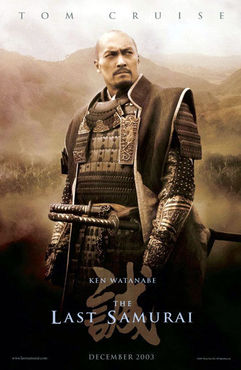 Summer has left my old friend Smokin’ Joe Matsumoto a broken man. Not quite broken, more like washed up; the heavy rain and typhoons which rolled through the Good Hood of Himeji this year ravaged his kitchen garden and left him king of a teeny weeny harvest. Even the watermelon thieves passed his patch over this year. I have never seen a man smoke a cigarette more despondently. He tosses me an eggplant the size of light bulb, wearing a frown that could hold rainwater. “Don’t take it so bad. The watermelon thieves will be back next year,” I say. “Hardy-hah (Japanese equivalent),” says he. “How’s your slug problem?” “I’ve run out of salt.” “You should move out of that old house.” “That’s what I tell the slugs.” “What do they say?” “When Buddha wills it.” “You should talk to Buddha.” “I’ll Skype him tonight.” “I mean you should REALLY talk to Buddha. Climb the holy mountain and talk to him.” “What holy mountain?” “Shosha-zan.” “You mean the place where they filmed The Last Samurai?” “Never seen it. What's it about?" “It's about a small American guy with a big nose who forces the samurai to speak English." “We leave at dawn." And so, with emotional baggage to purge, the Australian and the old Kitchen Gardener wobble off into a September dawn on bicycles they can only dream of burning their names in the road with. Shosha-zan, the ‘Mount Hiei of the West,’ is a holy mountain, home to a small Buddhist community of the Tendai sect, on which the towering Engyoji temple pavilions serve as its centrepiece. At this hour the venerable mount lies wreathed in mist, a sleeping giant on the outskirts of the city. We ditch the bikes and through rice fields clouded in dragonflies we hike, before ascending a zig-zag path through rock, scrub and cedar forest, until the air cools and the sounds of the city fade into bird song. I keep two strides ahead of Smokin’, who, at 71 years old, believes progress up a mountainside is measured not in mossy stone markers but in cigarettes smoked. Kudos to him when he holsters his Zippo at the edge of the old wooden temple precinct. There, a monk in black and white robes stands waiting in the courtyard. He is a big man with small round spectacles which balance on his nose. He, too, is dwarfed by the thousand-year-old pavilions with sloping tiled roofs and gargoyle keepers. The monk holds a long wooden paddle in his hands. He pats it gently against the palm of his meaty hand and smiles at our approach. Smokin greets him like an old friend. They are old friends, from an aikido class years ago. With greetings exchanged we are ushered up the steps of Jogyodo, the Training Hall, whereupon the monk halts and turns to me. “It is dark inside and for the next 30 minutes you and Matsumoto-san will be alone with yourselves in the presence of Buddha. Empty your mind, breathe deeply and lower your eyelids. But do not sleep.” He pats the paddle. Into the fragrant depths I step, moving barefoot across smooth wooden floor until I reach the edge of illumination. Rising above us at the centre of the room sits the All-Seeing One, gilded in gold foil and lit from above. His narrowed eyes peer down on us with an infinity of calm. We lower ourselves onto cushions the size of a frisbee, sit cross-legged, forming the circular sign of emptiness with our fingers. We shutter our eyelids to slits, draw deeply on the air and purge our minds of all thoughts of slugs, cigarettes, undersized melons, bikini girls and coconut oil. Time passes. And yet it does not pass. Time is merely a concept, so how can it be measured if I cannot consciously detect any change in my personal circumstance? The answer to that lies in the monk’s big wooden paddle. WHACK! WHACK! WHACK! I must have dozed. For this misdemeanor I take my punishment of three stiff blows to each shoulder and thank my punisher with hands clasped and a reverent bow. Each breath returns me to emptiness and time, once again, begins to fade. Buddha smiles on the two small men from the lowlands. My eyelid pops up. That's it! Watanabe Ken (below) sat beneath this very Buddha in the Last Samurai…. WHACK! WHACK! WHACK!
0 Comments
|
This Blog:What is the essence of a traditional Japanese neighbourhood? Writing from my home in Himeji, a castle town in western Honshu, Seaweed Salad Days distills, ferments, presents! Archives
March 2024
Categories
All
|


 RSS Feed
RSS Feed
